
5.6 - Control point
The control point represents the water temperature that the unit
must produce. The heat exchanger entering water temperature
is controlled by default, but the heat exchanger leaving water
temperature can also be controlled (requires a Service configu
-
ration modification).
Control point = active se reset
5.6.1 - Active setpoint
Two setpoints can be selected as active in cooling mode and
two in heating mode. Usually, the second setpoint is used for
unoccupied periods.
Depending on the current operating type, the active setpoint
can be selected:
•
by choosing the item in the GENUNIT menu,
•
via the user’s volt-free contacts,
•
via network commands,
•
via the setpoint timer program (schedule 2).
The following tables summarise the possible selections de-
pending on the control types (local, remote or network) and the
following parameters:
•
Setpoint select in local control: item LSP_SEL in the
GENUNIT menu permits selection of the active set-point, if
the unit is in local operating type.
•
Heating/cooling operating mode.
•
Setpoint selection contacts: setpoint selection contact status.
•
Schedule 2 status: schedule for setpoint selection.
LOCAL OPERATING MODE
PARAMETER STATUS
Heating/cooling
operating mode
Local setpoint
selection
Time schedule 2
status
Active
setpoint
Cooling
sp 1
-
Cooling setpoint 1
Cooling
sp 2
-
Cooling setpoint 2
Cooling
auto
occupied
Cooling setpoint 1
Cooling
auto
unoccupied
Cooling setpoint 2
Heating
sp1
-
Heating setpoint 1
Heating
sp 2
-
Heating setpoint 2
Heating
auto
occupied
Heating setpoint 1
Heating
auto
unoccupied
Heating setpoint 2
REMOTE OPERATING MODE
PARAMETER STATUS
Heating/cooling
operating mode
Setpoint selection
contact
Active setpoint
Cooling
sp 1 (open)
Cooling setpoint 1
Cooling
sp 2 (closed)
Cooling setpoint 2
Heating
sp 1 (open)
Heating setpoint 1
Heating
sp 2 (closed)
Heating setpoint 2
5.6.2 - Reset
Reset means that the active setpoint is modified so that less
machine capacity is required (in cooling mode, the setpoint is
increased, in heating mode it is decreased). This modification
is in general a reaction to a drop in the load. For the Pro-Dialog
control system, the source of the reset can be configured in the
HCCONFIG configuration: it can be provided either by the out
-
door temperature (that gives a measure of the load trends for
the building) or by the return water temperature (heat exchanger
delta T, gives an average building load).
In response to a drop in the outdoor temperature or to a drop in
delta T, the cooling setpoint is normally reset upwards in order
to optimise unit performance:
In both cases the reset parameters, i.e. slope, source and maximum
value, are configurable in the RESETCFG menu (see section
4.3.8). Reset is a linear function based on three parameters.
•
A reference at which reset is zero (outdoor temperature
or delta T - no reset value).
•
A reference at which reset is maximum (outdoor
temperature or delta T - full reset value).
•
The maximum reset value.
Reset example in cooling mode based on the outside temperature
Legend
A Maximum reset value
B OAT or delta T for no reset
C OAT or delta T for full reset
D Building Load
5.7 - Demand limit
The demand limit is used to restrict the unit power consump-
tion. The Pro-Dialog control system allows limitation of the unit
capacity, using user-controlled volt-free contacts.
The unit capacity can never exceed the limit setpoint activated
by these contacts. The limit setpoints can be modified in the
SETPOINT menu.
5.8 - Night mode
The night period is defined (see GENUNIT configuration) by a
start time and an end time that are the same for each day of
the week. During the night period, the number of fans operating
can be reduced, and the unit capacity may be limited.
Reset v
alue
Outdoor temperature (OAT)
Heat exchanger delta T
% Building load
5 - PRO- CONTROL OPERATION
EN - 19
EREBA ACCESS
Содержание PRO-DIALOG+
Страница 1: ...Instruction manual EREBA ACCESS 8 40 kW 11 2016 10183 PRO DIALOG...
Страница 2: ......
Страница 27: ......








































